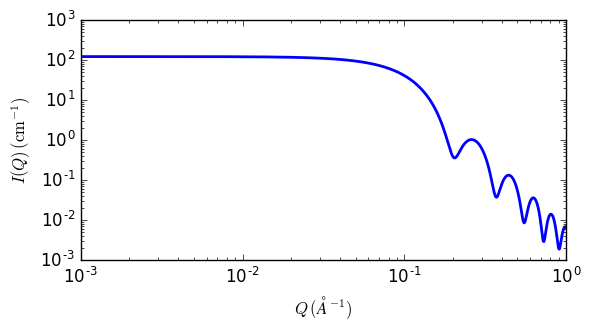rectangular_prism
Rectangular parallelepiped with uniform scattering length density.
| Parameter | Description | Units | Default value |
|---|---|---|---|
| scale | Source intensity | None | 1 |
| background | Source background | cm-1 | 0.001 |
| sld | Parallelepiped scattering length density | 10-6Å-2 | 6.3 |
| sld_solvent | Solvent scattering length density | 10-6Å-2 | 1 |
| length_a | Shorter side of the parallelepiped | Å | 35 |
| b2a_ratio | Ratio sides b/a | Å | 1 |
| c2a_ratio | Ratio sides c/a | Å | 1 |
The returned value is scaled to units of cm-1 sr-1, absolute scale.
This model provides the form factor, \(P(q)\), for a rectangular prism.
Note that this model is almost totally equivalent to the existing parallelepiped model. The only difference is that the way the relevant parameters are defined here ($a$, \(b/a\), \(c/a\) instead of \(a\), \(b\), \(c\)) which allows use of polydispersity with this model while keeping the shape of the prism (e.g. setting \(b/a = 1\) and \(c/a = 1\) and applying polydispersity to a will generate a distribution of cubes of different sizes). Note also that, contrary to parallelepiped, it does not compute the 2D scattering.
Definition
The 1D scattering intensity for this model was calculated by Mittelbach and Porod (Mittelbach, 1961), but the implementation here is closer to the equations given by Nayuk and Huber (Nayuk, 2012). Note also that the angle definitions used in the code and the present documentation correspond to those used in (Nayuk, 2012) (see Fig. 1 of that reference), with \(\theta\) corresponding to \(\alpha\) in that paper, and not to the usual convention used for example in the parallelepiped model. As the present model does not compute the 2D scattering, this has no further consequences.
In this model the scattering from a massive parallelepiped with an orientation with respect to the scattering vector given by \(\theta\) and \(\phi\)
where \(A\), \(B\) and \(C\) are the sides of the parallelepiped and must fulfill \(A \le B \le C\), \(\theta\) is the angle between the \(z\) axis and the longest axis of the parallelepiped \(C\), and \(\phi\) is the angle between the scattering vector (lying in the \(xy\) plane) and the \(y\) axis.
The normalized form factor in 1D is obtained averaging over all possible orientations
And the 1D scattering intensity is calculated as
where \(V\) is the volume of the rectangular prism, \(\rho_\text{p}\) is the scattering length of the parallelepiped, \(\rho_\text{solvent}\) is the scattering length of the solvent, and (if the data are in absolute units) scale represents the volume fraction (which is unitless).
The 2D scattering intensity is not computed by this model.
Validation
Validation of the code was conducted by comparing the output of the 1D model to the output of the existing parallelepiped model.

Fig. 61 1D plot corresponding to the default parameters of the model.
References
P Mittelbach and G Porod, Acta Physica Austriaca, 14 (1961) 185-211
R Nayuk and K Huber, Z. Phys. Chem., 226 (2012) 837-854